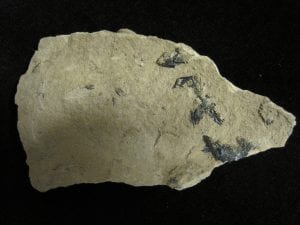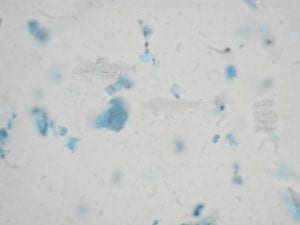Vivianite: Office of the Vice-Provost for Education and Student Affairs
By Ruth Siddall, on 31 January 2017
The colour and pigment I (Ruth Siddall) have chosen to represent my department, the Office of the Vice-Provost for Education and Student Affairs (that’s right guys, I’m taking you all down with me) in the Pigment Timeline Project is vivianite. The reason is simply that it is a rather beautiful pigment, it looks good under the microscope and I just like its colour, a shade of greyish blue. It is also an unexpected earth pigment, being blue and therefore standing out from the usual gamut of yellows, browns, reds and blacks that we associate with the word ‘ochre’. Another reason is that it is the first pigment to appear in The Pigment Compendium’s Optical Microscopy volume.
Vivianite is not a well-known pigment, and it is a true fact that lack of knowledge of the existence of a pigment directly correlates to the likelihood of its identification on a painted object. I feel that the more we know about and recognise this mineral pigment, the more it will be identified.
Vivianite is a mineral forming in the natural geological environment. Chemically, it is an iron phosphate hydrate (Fe2+3(PO4)2· 8HO); when unexposed to oxygen it is colourless, but oxidation produces a blue or green colouration as the Fe2+ ions convert to Fe3+. Dig into a peat bog, and the bright blue can form before your eyes.
Vivianite was first discovered by John Henry Vivian a Cornish politician, mine owner and mineralogist at the Wheal Kind Mine near St Agnes. Vivian did not name the mineral himself, but it was named after him by Abraham Gottlob Werner 1817. It can form beautiful, bladed, gem quality crystals, but in terms of its use as a pigment, I am more interested in the earthy, friable forms; ‘blue earth’ or ‘blue ochre’.

Vivianite crystals on London Clay from West Leigh, Hampshire
To act as a good pigment, a mineral needs to be soft enough to grind to a fine powder, and to be able to retain its colour when finely ground. This is, by far, not a universal property; many minerals which are strongly coloured in hand specimen, lose their colour completely when finely ground. Naturally occurring, blue minerals are not common and so, when encountered in peat bogs and similar environments, vivianite would have attracted the eye with its striking paint-making potential.
Vivianite is very easy to recognise using polarising light microscopy. It has intense blue-to-colourless pleochroism as the microscope stage is rotated. Compare the two images below, both the same field of view, from the Pigment Compendium reference collection.


This sample, P1353 was donated to us by Rowena Hill. It comes from the Southern Highlands of Papua New Guinea, where Rowena was studying the use of the pigment in ethnographic contexts. It was collected in 1986.
Geologically, vivianite forms in damp, anoxic environments in the presence of phosphate and the absence of sulphur. My only geological sample , a gift of colleague, Peter Hay is from the London Clay, collected from West Leigh Landfill Site near Havant in Hampshire (see photo above). Dark blue bladed crystals have grown on the surface. Apart from an association with dead bodies (more later), this mineral is most commonly encountered in peat bogs, though this is something I have never personally observed. Indeed the only field photo I have seen of vivianite in situ in sediments is in Dill & Techmer’s 2009 paper on ‘ferricretes’ in Bavaria. If anyone out there has field photographs of vivianite in the geological environment, I would love to see them! It should also be noted that vivianite commonly turns up as a corrosion product in archaeological finds, particularly on iron artefacts (see for example, Scott & Eggert, 2007).

Vivianite forming in clays and silts in Bavaria, from Dill & Techmer (2009).
Dead bodies are a good source of phosphate in the form of bone – chemically calcium hydroxyl apatite, Ca5(PO4)3(OH) – and spectacular blooms of vivianite have been noted on human remains, famously it was found in the body of Ötzi, the Tyrolean ice man (see Pabst & Hofer, 1998). It has become an unintentional habit of this blog to stray into the more macabre associations of pigments and their derivation and uses, and so I feel I should introduce readers to ‘Brienzi, the blue vivianite man of Switzerland’. Brienzi (not his real name) was drowned in the Brienzersee in Switzerland, probably in the 18th Century AD. The remains of his corpse was exposed by a landslide and discovered in 1996 (Thali et al, 2011). Preserved fat was seen to be coated in vivianite. Click here for images. Or not. The mineral has also been found on more recent remains of US airmen who went missing in action during the Vietnam War (Mann et al., 1998), demonstrating that it forms geologically rapidly.
Records of vivianite’s occurrence on works of art are not abundant. Known examples include tentative identifications on works by Vermeer and several other examples which are listed in Scott & Eggert (2007) and also in the Pigment Compendium (Eastaugh et al., 2004). Use is more or less restricted to 17th and 18th Century western painting , with a few occurrences in in post-Roman and Medieval art and ethnographic use in New Zealand (Hamilton, 1896), Papua New Guinea (Hill, 2001) and particularly in art of the Pacific Northwest of North America.
I visited Alaska in 2008 to attend a conference and whilst there went to see the amazing exhibition ‘Yuungnaqpiallerput / The Way We Genuinely Live’ (Fienup-Riordan, 2007), which showcased artefacts, experiences and memories demonstrating the adaptability of the local Yup’ik people to their environment. The Yup’ik used red and yellow ochres and chalks as pigments but also used vivianite to paint masks and other artefacts. An interview with local man Paul John recalled kayaking out to collect pigments from Nelson Island with his grandfather and others, where vivianite was exposed high up, in cliff sections. His grandfather’s rifle was an essential tool in the procurement of this particular pigment; “Since it’s hard to reach, they sometimes shot at the mountainside to get it.”
Vivianite pigment is available to buy from artists’ colourmen today. My colleague and fellow Pigment Timeliner Jo Volley is, at the time of writing, installing an artwork in UCL’s Front Lodge. Called ‘Sampler II’, it contains stripes of pure pigment including mineral vivianite.



Jo Volley , 2017, ‘Sampler II’
References and further reading
Dill, H. & Techmer, A., 2009, The geogene and anthropogenetic impact on the formation of per descensum vivianite–goethite–siderite mineralization in Mesozoic and Cenozoic siliciclastic sediments in SE Germany., Sedimentary Geology 217, 95–111.
Eastaugh, N., Walsh, V., Chaplin, T., & Siddall, R., 2008, Pigment Compendium: A Dictionary and Optical Microscopy of Historic Pigments. (1st ed.). London: Butterworth-Heinemann., 958 pp.
Fienup-Riordan, A., 2007, Yuungnaqpiallerput / The Way We Genuinely Live: Masterworks of Yup’ik Science and Survival., University of Washington Press., 360 pp. & Yup’ik Science: working with bone, stone and ivory; http://www.yupikscience.org/10wintervillage/10-3.html
Hamilton, A., 1896, Maori Art, Harmer Johnson, London.
Hill, R., 2001, Traditional paint from Papua New Guinea: context materials and techniques, and their implications for conservation., The Conservator, 25, 49-61.
Hrala, J., 2016, This strange mineral grows on dead bodies and turns them blue., http://www.sciencealert.com/vivianite-the-blue-mineral-that-eerily-turns-buried-bodies-blue
Mann, R. W., Feather, M. E., Tumosa, C. S., Holland, T. D. & Schneider, K. N., 1998, A blue encrustation found on skeletal remains of Americans missing in action in Vietnam., Forensic Science International, 97, 79-86.
Mindat; Vivianite: http://www.mindat.org/min-4194.html
National Gallery, London: Vermeer’s palette; https://www.nationalgallery.org.uk/paintings/research/meaning-of-making/vermeer-and-technique/vermeers-palette
Pabst, M., and Hofer, F., ‘Deposits of different origin in the lungs of the 5,300-year-old Tyrolean Iceman’, American Journal of Physical Anthropology 107 (1998) 1–12.
Scott, D. A & Eggert, G., 2007, The vicissitudes of vivianite as pigment and corrosion product, Studies in Conservation, 52, 3-13.
Thali, M. J., Lux, B., Lösch, S., Rösing, F. W., Hürlimann, J., Feer, P., Dirnhofer, R., Königsdorfer, U. & Zollinger, U., 2011, ‘‘Brienzi’’ – The blue Vivianite man of Switzerland: Time since death estimation of an adipocere body., Forensic Science International 211, 34–40.
Volley, J., 2017, “Sampler II”
5 Responses to “Vivianite: Office of the Vice-Provost for Education and Student Affairs”
- 1
-
2
Chauncey wrote on 6 March 2017:
Hello There. I found your weblog using msn. This
is a really smartly written article. I will be sure to bookmark it and return to learn more of your helpful info.
Thank you for the post. I will definitely return. -
3
Indocin.sefc.info wrote on 9 March 2017:
Piece of writing writing is also a fun, if you be acquainted with then you can write or else it
is complicated to write. -
4
Melisa wrote on 20 April 2017:
I have read so many content regarding the blogger lovers however this piece of writing
is truly a pleasant post, keep it up. -
5
Melonie Ancheta wrote on 30 May 2018:
I know Fienup-Riordan is a source of yours. I’d just like to point out she is building from the original work of Dorothy Jean Ray, an anthropologist who spent much of her life among the Aleut. Ray was the first person to document use of vivianite among the Aleut and the first to have it scientifically identified. I’m familiar with both Ray’s and F-R’s work, and in fact, I am the person who ran analysis on F-R’s sample of vivianite for her.
 Close
Close



You can definitely see your expertise in the article you write.
The sector hopes for even more passionate writers like you who aren’t
afraid to mention how they believe. At all times follow your
heart.